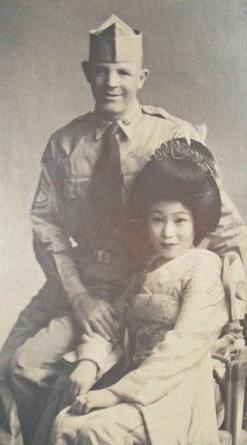"With an honest brush I painted a portrait of myself"

A feature of Guo’s exhibit is a self-portrait, When I Am Alone
Elisabeth Curtis
February 27, 2024
My grandmother was seven months pregnant with my father when she arrived in the United States in 1952, and never saw her family or her home country again.
She was one of thousands of Japanese women who married American soldiers post-war and relocated to America to start a new life. It was a time of assimilation, when the priority was integrating into society as much as possible. She was 47 when she died on the operating table of an American hospital in Oklahoma. It’s so sad to me that I know almost nothing about my heritage because it was not popular to be an immigrant in the 1950’s, especially one from an “enemy” nation, so my father knew almost nothing about this part of his mother, and was unable to pass on any cultural information to his children.

Coy Tibbs and Teruko Sakamoto wedding photo
I’ve always had a fascination with people’s stories. Everyday people. People who might give me some idea of what life might have been like for my grandmother. Yidan Guo, master’s student in the Department of Art at Idaho State brings us a room full of stories through art in her exhibit, Women Who Are Asian Immigrants: The Seen and Unseen, at the Davis Gallery on the Pocatello Campus. I am struck by these faces and wish I had been there with her when she interviewed each of these women to hear their stories.
“My life started over again the day I arrived in the United States ten years ago,” Guo’s exhibit preface states. “As a woman who is an Asian immigrant and artist, I pay extra attention to immigrant women, especially Asian immigrant women.”
Guo gives faces to these individuals, women in portraits that gaze directly at the viewer. She gives voices to the thousands of Chinese workers who worked and died to create the Central Pacific Railway. Their presence is marked by colorful swaths of red and golden-yellow paper. It is impossible not to be struck by the vibrant colors and graceful draping that takes up the entirety of the heart, the center, of the gallery. I wonder what the words, written in Chinese calligraphy, say. I am the outsider, wishing I could understand.
.jpg)
These two commemorative banners record the history of Chinese's contributions to the construction of the transcontinental railroad
In a handful of portraits, the women are doing something with their hands, which mime with no object. I reflect on what these unseen actions mean.
Guo's exhibit preface says, "In daily life, I am often asked, Where are you from? My appearance and foreign accent do not blend within American society."
No one has ever asked me where I’m from in that way. I don’t know what it feels like to be an outsider. As I grow older, I grow more aware of all that my grandmother sacrificed and lost by coming to America, and am deeply grateful for artists like Guo who help me see and experience the tiniest bit of my history. I brought my daughter with me.
A feature of Guo’s exhibit is a self-portrait, When I Am Alone. Of this piece, Guo says, “I found a tripod and put my old camera on it. Stood in front of the camera, I let it capture the most authentic version of myself. At that moment I didn’t care whether I looked good or not, because I had been pretending for so long…I painted a portrait of myself that had long been avoided and neglected.”
.jpg)
"I let it capture the most authentic version of myself"
Women Who Are Asian Immigrants: The Seen and Unseen is an honest and beautiful tribute to a handful of women and thousands of the unseen and unheard. The exhibit has been extended to March 8.
The John B. Davis Gallery, located on the lower level of the Fine Arts Building, is dedicated to exhibiting original artwork that advances knowledge of contemporary art production and display by emerging and established artists. For more information contact the Department of Art at art@isu.edu | (208) 282-2361. Gallery hours are M-F 12-6 PM.

